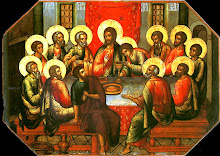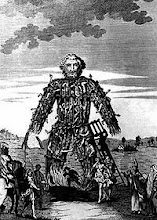But, people being what they (we) are, Girard shows that myths worldwide show not only the necessary scapegoat mechanism at the heart of culture, but also cultural breakdown from time to time. Gil Bailie, for my money the best popularizer of mimetic theory, explicates in his book, Violence Unveiled (Crossroads, 1996), a myth of the Toltec peoples that shows exactly this crisis: a time when an "economic" sacrificial mechanism needing only one or a few victims moved to an inefficient and murderous cultural development - one that usually signals the death-throes of a culture. (This myth of Quetzalcoatl and Tezcatlipoca can be read on pp. 99ff.)
Western civilization is now by all accounts in this stage of cultural dilapidation. Robert Hamerton-Kelly says that a certain indicator of a culture that is losing its centripetal power to hold its people together socially and psychologically is seen in a bipartite characteristic - its need to throw more victims into the sacrificial mechanism, or more prestigious victims: genocide or regicide. Democracy itself, he theorizes, is the cultural concretization of the death of kings (Louis XVI, Charles I). The 20th century shows graphically the decline of the West using this indicator.
What Girard discovered in his groundbreaking studies in cultural anthropology - "mimetic theory" - was the effect of the Gospel in history. He was flabbergasted as any scholar would be to turn in his literary and mimetic studies to the New Testament and find that the Bible seemed to understand the dynamics of mimetic theory as well or better than he. (I suggested strongly to the reader both Girard's Violence and the Sacred [Johns Hopkins, 1977] and The Scapegoat [Johns Hopkins, 1986] in this regard.) I won't go into all of his findings, but this is a quote from his book, Things Hidden Since the Foundation of the World:
“Jesus is not there in order to stress once again in his own person the unified violence of the sacred. He is not there to ordain and govern like Moses; he is not there to unify people around him, to forge its unity in the crucible of rites and prohibitions. But on the contrary, to turn this long page of human history once and for all" [204]
How "satanic"? Recall: etymologically, the Greek word "satan" is synonymous with "the accuser." It is the accusatory gesture that establishes the first notions of human culture ("It's HIS fault!"); the murder or casting out of the scapegoated victim is the second part of originary culture-making scene. By definition, Satan is the "murderer and liar from the beginning" who creates all the world's kingdoms and powers (Jn 8). Astonishingly, the Greek word used in the New Testament for the Holy Spirit, "paraklete" means "counselor for the defense," "comforter," one who stands with the accused.
Girard was overwhelmed to see in the Gospels an alternative to the conventional cultures of the world universally depicted in the anthropological record. This new Kingdom was initiated, said the Church (unified for 1,500 years +/-), by a loving, forgiving, and self-disclosing God who went to the extreme measure of becoming one-with us (the Incarnation), suffering our human bloodthirstiness to the point of death (the Crucifixion), and rising from the dead not to reek havoc, but to offer repentance and a new Way of being in the world (the Resurrection and giving of the Holy Spirit at Pentecost); namely, the ecclesia, the Church. This Way did not expel or murder a victim or victims to convene itself (ask what cultures demand this today). Rather, the Church into which this Risen Lord invites all peoples convenes by gathering around the "lamb slain since the foundation of the world," his Altar, his Word, his Love. The Sacrifice of the Mass he instituted so that we would not again seek human victims to do the satanic thing.
+ + +
Where has this Gospel brought us? At its high point, it brought to flower Christendom. Yes, reform was essential and called-for, but the so-called "reformation" began a scourge that has led Christendom to the brink of breathtaking demise. Shall it find unity and a restoration? Or, will the primitive Sacred swallow it in its two-pincer vice-grips of postmodern nihilism, on the one hand, and the religion of the Scimitar on the other once and for all?








1 comment:
Great essay (in three parts).
Thanks for sending this on to me to read.
Girard has made me see the world in a new way. I have always believed that death and resurrection of Christ represented a new meme, and that it changed the world, but I never knew how to articulate this change.
The other thing the death of Christ did was insure to all people the legitimacy of our Freedom and Equality before the One God.
If all of us are so important to God that He would die for us, so that we can be cleaned, and so that He can then take up residence in our spirits, then we know that we are Unique, important beings capable of Freedom and Creativity, just the the God in whose Image we were Created in the first place.
The problem is, this idea is not articulated very clearly, and it has not been articulated to the whole world.
So, it has not changed the world, as it could. It has changed the world, to be sure, but not like it could.
Email me when you get a chance.
cuanasblog@yahoo.com
Post a Comment